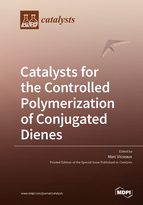Catalysts for the Controlled Polymerization of Conjugated Dienes
A special issue of Catalysts (ISSN 2073-4344). This special issue belongs to the section "Catalytic Materials".
Deadline for manuscript submissions: closed (31 December 2018) | Viewed by 31156
Special Issue Editor
Interests: coordination chemistry; rare earths; organometallic catalysis; controlled polymerization; olefins/conjugated dienes/styrene; ROP
Special Issue Information
Dear Colleagues,
The polymerization of conjugated dienes is a domain of interest for both academic and industrial research. In a context where the control of the process is always to be improved—in terms of (but not limited to) efficiency, micro-structure, etc.—and whereas environmental concerns have, nowadays, to be taken into consideration, the development of new catalysts is still a necessary and modern challenge. This includes molecular catalysts comprising less toxic metals, as single component or as dual catalytic combinations. The implementation of the recent concepts of the field, such as coordinative chain transfer polymerization or chain shuttling polymerization, and the application to the (co-)polymerization of recently introduced bio-sourced conjugated dienes as monomers are also of high interest.
The aim of this Special Issue is, thus, to cover promising recent research and novel trends in the field of the development and application of new catalysts for conjugated dienes polymerization and copolymerization. Contributions from all areas of homogeneous/supported catalysis, based on experimental results and/or mechanistic approaches, would be of great interest.
Prof. Dr. Marc Visseaux
Guest Editor
Manuscript Submission Information
Manuscripts should be submitted online at www.mdpi.com by registering and logging in to this website. Once you are registered, click here to go to the submission form. Manuscripts can be submitted until the deadline. All submissions that pass pre-check are peer-reviewed. Accepted papers will be published continuously in the journal (as soon as accepted) and will be listed together on the special issue website. Research articles, review articles as well as short communications are invited. For planned papers, a title and short abstract (about 100 words) can be sent to the Editorial Office for announcement on this website.
Submitted manuscripts should not have been published previously, nor be under consideration for publication elsewhere (except conference proceedings papers). All manuscripts are thoroughly refereed through a single-blind peer-review process. A guide for authors and other relevant information for submission of manuscripts is available on the Instructions for Authors page. Catalysts is an international peer-reviewed open access monthly journal published by MDPI.
Please visit the Instructions for Authors page before submitting a manuscript. The Article Processing Charge (APC) for publication in this open access journal is 2700 CHF (Swiss Francs). Submitted papers should be well formatted and use good English. Authors may use MDPI's English editing service prior to publication or during author revisions.
Keywords
- Coordination catalysis
- Stereo-selective polymerization
- Conjugated dienes
- Chain transfer
- Rare earths
- Main-group metals
- Allyl
- Organometallics
- Reaction mechanisms
- Computational calculations






